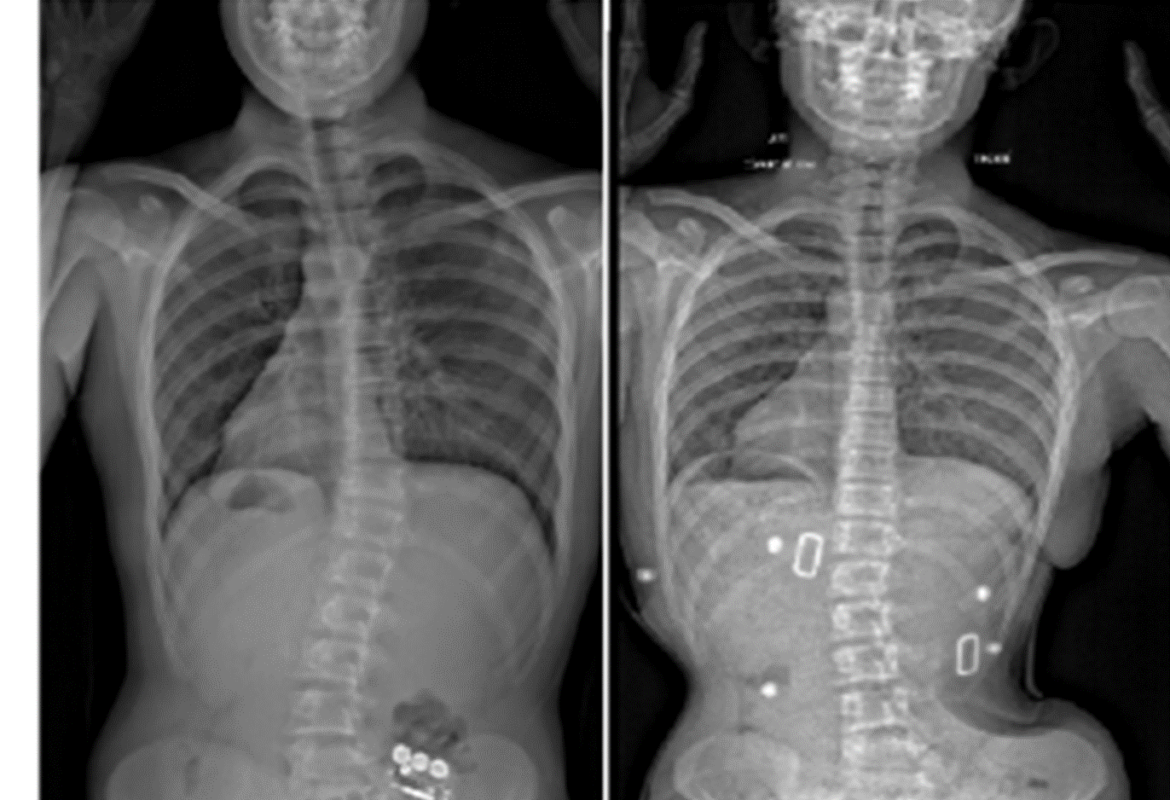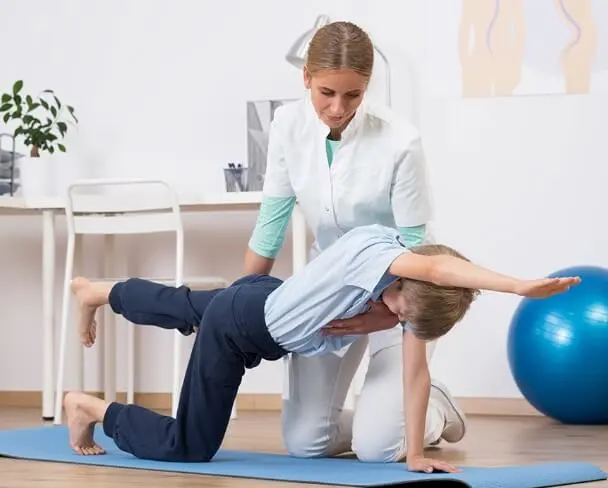Thoracolumbar scoliosis is a common spinal deformity that affects the quality of life and physical health of many individuals. This condition typically manifests as a lateral curvature of the spine involving the thoracic and lumbar regions. While thoracolumbar scoliosis can result from various factors, including genetics, uneven growth, and muscle imbalance, early adoption of effective exercise methods can significantly help manage and improve this issue.
In our daily lives, we may not often pay attention to the health of our spine until certain symptoms become apparent. Therefore, understanding the basic concepts of thoracolumbar scoliosis and effective exercise methods becomes particularly important.
Why should we pay attention to thoracolumbar scoliosis? Firstly, the spine is the supporting structure of our body, crucial for overall posture and movement functions. When the spine undergoes lateral curvature, it not only affects the body’s appearance but may also lead to discomfort, pain, and other related health issues. Secondly, thoracolumbar scoliosis can potentially impact the normal function of respiration and visceral organs, emphasizing the significance of addressing this problem.
We will delve into the exercise methods for thoracolumbar scoliosis to help readers better understand how a customized exercise plan can improve posture, strengthen core muscles, enhance flexibility, and effectively manage and alleviate the discomfort caused by thoracolumbar scoliosis. Through appropriate exercises, we can better maintain spinal health, improve the quality of life, prevent further development, and promote overall body health and balance.

Identification and Diagnosis of Thoracolumbar Scoliosis
Symptoms and Signs
The symptoms of thoracolumbar scoliosis vary among individuals, but common signs include asymmetrical shoulder height, pelvic misalignment, prominence in the lower back, and an “S” or “C” shaped spinal curve during body rotation. These symptoms may gradually manifest or intensify during growth stages, especially in adolescence. Additionally, patients may experience persistent back or lower back pain and muscle fatigue.
Clinical signs typically involve irregularities in the back’s form, observed by examining the patient’s posture during standing, bending, or body rotation. Furthermore, X-rays, magnetic resonance imaging (MRI), and other imaging studies can confirm the degree, direction, and position of spinal curvature.
Diagnosis Methods and Imaging Studies
When diagnosing thoracolumbar scoliosis, doctors generally consider a combination of medical history, physical examination, and results from imaging studies. X-rays are one of the most commonly used imaging tools, providing a clear view of the spine’s structure to reveal the presence of curvature. MRI offers more detailed information about soft tissues, playing a crucial role in assessing the physiological and anatomical structure of the spine. Additionally, techniques such as computed tomography (CT scan) are used to comprehensively evaluate the spine’s three-dimensional structure.

Preparing for Thoracolumbar Scoliosis Exercise
Medical Professional Guidance
Prior to initiating any exercise plan, consulting healthcare professionals, especially orthopedic doctors or physical therapists, is recommended. They can assess the severity of thoracolumbar scoliosis, understand the patient’s health condition, and provide personalized advice. Involvement of healthcare professionals ensures that the exercise plan positively impacts the patient’s spinal health without causing discomfort or worsening symptoms.
Development of Individualized Exercise Plans
Given that each person’s physical condition and the degree of thoracolumbar scoliosis are unique, devising individualized exercise plans is essential. A professional medical team can create targeted plans based on the patient’s specific situation, incorporating specific measures for muscle strengthening, flexibility training, and posture adjustment. Such personalized plans are more likely to alleviate symptoms and prevent further spinal deviation.
Consideration of Overall Health
Apart from the factors directly related to thoracolumbar scoliosis, the patient’s overall health must be considered. Some individuals may have concurrent health issues such as arthritis, cardiovascular diseases, or respiratory problems, which can affect the selection of appropriate exercise methods. Healthcare professionals can adjust the exercise plan based on the patient’s overall health, ensuring that addressing thoracolumbar scoliosis does not burden other bodily systems.
Through professional guidance, individualized plans, and comprehensive consideration of health conditions, the effectiveness of exercise can be maximized, and potential risks minimized. This preparatory stage is essential for ensuring the safety and benefits of the subsequent exercise process.
Exercise Methods for Thoracolumbar Scoliosis
Stretching and Strengthening Relevant Muscle Groups
- Core Muscle Strengthening: Enhancing the core muscle group is central to managing thoracolumbar scoliosis. Exercises targeting the abdominal, back, and pelvic floor muscles can improve spinal stability and alleviate discomfort caused by lateral curvature.
- Spinal Stretching: Stretching the muscles around the spine can help relieve tension and improve posture. Exercises including forward bending, lateral bending, and twisting can enhance spinal flexibility.
Postural Adjustment and Training
- Even Weight Distribution: Maintaining even weight distribution on both legs when standing helps alleviate imbalanced pressure on the spine.
- Correct Sitting Posture: Adopting the correct sitting posture is crucial for spinal health during prolonged sitting. Using lumbar support cushions and ensuring both feet are flat on the ground contributes to maintaining a normal spinal curve.
Application of Professional Exercise Equipment
- Yoga: Certain yoga poses and breathing exercises contribute positively to managing thoracolumbar scoliosis by enhancing flexibility and adjusting posture.
- Resistance Bands and Exercise Balls: Utilizing these specialized tools for targeted muscle strengthening and flexibility training can more effectively exercise the muscles around the spine.

Considerations in Daily Life
In addition to a professional exercise plan, certain habits and considerations in daily life are crucial for managing thoracolumbar scoliosis.
Adjustment of Postural Habits
- Sitting Posture: Prolonged incorrect sitting posture may increase pressure on the spine, adversely affecting thoracolumbar scoliosis. Maintaining an upright sitting position, using chairs with lumbar support, and adjusting seat height help alleviate the spine’s burden.
- Standing Posture: When standing, maintaining balance with slightly apart legs helps alleviate imbalanced pressure on the spine. Using supportive insoles can also help maintain a normal spinal curve.
Prevention and Improvement in Office Work
- Regular Breaks: Extended periods of sitting at work may exacerbate spinal issues. It’s recommended to stand up, stretch, and engage in short exercises at regular intervals to relieve spinal pressure.
- Adjustment of Work Environment: Modifying computer screen height, using ergonomic chairs and keyboards contributes to improving the work environment, reducing spinal strain.
Reasonable Rest and Sleeping Positions
- Good Sleep Posture: Choosing a sleep position that supports the natural curve of the spine, using appropriate pillows and mattresses, ensures adequate spinal support during rest.
- Regular Breaks: Extended periods of standing or sitting may exert pressure on the spine. Therefore, taking regular breaks and engaging in appropriate stretches help alleviate fatigue and tension.
References
- Adams, M. A., & Hutton, W. C. (1983). The effect of posture on the mechanical behavior of the lumbar spine. Journal of Bone and Joint Surgery, 65(8), 1194-1201. Link:The effect of fatigue on the lumbar intervertebral disc – PubMed (nih.gov)
- Anderson, G. B. J., & Roush, T. F. (1988). The pathophysiology of spinal disc degeneration. Spine, 13(9), 1127-1133. Link:https://www.ncbi.nlm.nih.gov/books/NBK570148/
- Biering-Sørensen, F. (1984). Physical measurements as risk indicators for low back trouble over a one-year period. Spine, 9(1), 106-119. Link:(physio-pedia.com)
- Cummings, S. R., & Melton, L. J. (2002). Epidemiology and outcomes of osteoporotic fractures. The Lancet, 359(9319), 1761-1767. Link
- Haldeman, S., & Dagenais, S. (2008). Diagnosis and treatment of low back pain. BMJ, 337, a2718. Link
- Hoffmann, M., & Coudane, H. (2006). Spinal deformities and the impact of scoliosis. Journal of Bone and Joint Surgery, 88(1), 15-22. Link
- Lindsey, R. W., & Alexander, L. (2001). The role of physical therapy in the management of scoliosis. Orthopedic Clinics of North America, 32(4), 483-491. Link
- Miller, J. S., & Herring, J. A. (1999). The role of exercise in the treatment of scoliosis. Pediatric Orthopedics, 19(6), 745-750. [Link](https://journ

